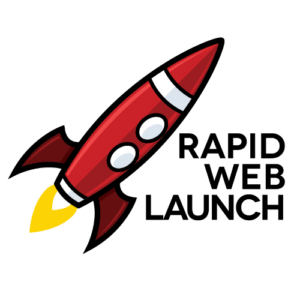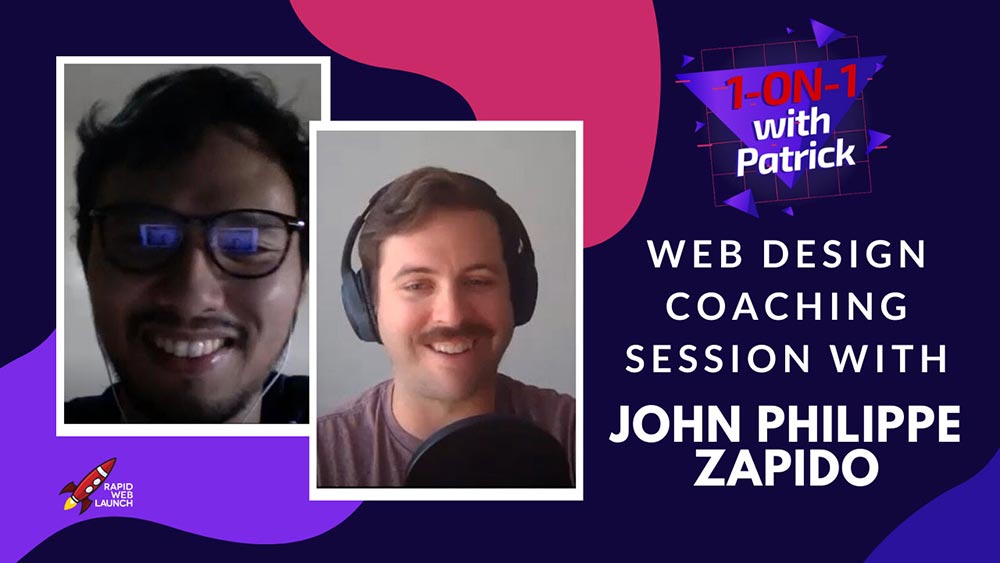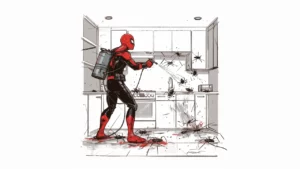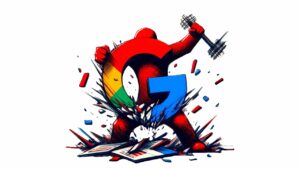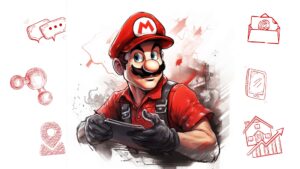1-on-1 with Patrick is a series of web design coaching sessions for wannabe web designers.
In this episode we have John Philippe Zapido from Manila, Philippines! We discuss:
- Where John is at with his web design business
- Overcoming fear of failure and rejection
- Patrick’s most-recommended entrepreneur book
- Why Patrick chose to use Elementor with his web design business
- Elementor vs Webflow
- Getting ultra-specific when choosing a web design niche
- Onboarding new clients and coming up with strategy
- What to do when your client isn’t happy with your work
- Staying laser-focused on your top priorities
Give it a listen! ????
Want a FREE 1-ON-1 web design coaching session? ???? Book a session
Subscribe to the Launchers podcast! ???? Choose your podcast platform
Tools & Resources Mentioned in This Episode
- Webflow
- Elementor
- Ahrefs
- Tailwind
- Shoe Dog by Phil Knight
- My Favorite Books
- Top Excuses Holding You Back From Starting Your Web Design Business
- How to Stay Focused in a Distracting World
- Why I Left Weebly and Moved to Wordpress
- Questions to Ask Your New Web Design Client
Episode Transcript
Where John is At With His Web Design Business
Patrick: Hey John, how’s it going?
John: I’m good. How about you?
Patrick: I can’t complain. So, you’re in Manila, right?
John: Yes, correct.
Patrick: How are things over there?
John: So, it’s tough for everyone, even for those who are working at home, like me. I’m one of those working at home.
Patrick: So, you told me a little bit about that. Why don’t you tell me a little bit about yourself what you do with web design and where you’re trying to go?
John: So currently I’m working for a web design agency. We target corporate websites or corporate companies. I’m working full time there and I’m currently building my web design on the side. So currently, I’m using Web Flow as my tool of choice because number one; the ease of use. And the other thing is as a designer, sometimes I prototype the projects that I work on with my company on the side. But it takes a lot of time to learn Web Flow.
Patrick: Okay. So, after so many years of working for a web design agency, why have you decided to go out on your own now?
John: I’ve only been working there for around three years and I am self -taught web designer. I just started I think in 2017 or 2018 dabbling with tools such as Inkscape and other free tools. I decided to transition to UX design and then eventually my friend who owns a UX agency got me. I think he looked at my Pinterest or something. I’m not sure. There’s a lot of design stuff on my Pinterest so he offered me a job to work there full time.
Patrick: Okay, that’s awesome. I always tell people that Pinterest is underutilized as a marketing tool. It’s a very powerful platform if you know what you’re doing. So, you taught yourself web design on your own, and then that’s how you were able to get a job with an agency? That’s what you’re saying?
John: Yes, I started learning UX design in interaction design foundation, if I remember correctly. I tried to apply for a few jobs, but eventually I got an offer from my friend. So, I have been blessed to get the offer.
Patrick: You can learn anything you want these days. All the information is out there for free. It’s just about putting in the time and you did that, so you were able to get a job out of it. That’s great. So, now that you’re transitioning to doing your own freelance type thing, what’s your biggest struggle or challenge so far?
John: Currently I’m working but I only have two clients. One is a client for a logo design and the other one is for web design. I’m having a hard time. The reason why I am having a hard time is that I think I’m a perfectionist. I’ve worked on just the homepage for this project for I think five hours. I think I’m spending too much time. I don’t know what the problem is. Is it being me being a perfectionist? Sometimes I think web design just not for me.
Overcoming Fear of Failure and Rejection
Patrick: So, you’re wondering if web design might not be something that’s for you?
John: Yes.
Patrick: Do you enjoy it?
John: Yeah. I enjoy designing websites especially when there’s what you call a eureka moment when you build something from scratch. But there are some times that I feel frustrated. I have the fear of not knowing what I will develop. So, can I do this thing or not with the piece of software that I’m using, or do I need a custom code? That’s what keeps happening every time I do websites.
Patrick: Every time you do websites.
John: Yes. For example, when the client asked me to do something, doing this on the side or earing on the side, I immediately say yes to the project without not knowing if I could do this thing or not or if I could learn along the way. So, I think that’s one of my mentalities; learning, learning by doing, but sometimes I think it’s defeating the purpose. It’s detrimental to the project.
Patrick: Okay. Have you ever had a website you’ve worked on where you started the project and then weren’t able to finish it?
John: I think there was one website for my girlfriend, for her travel company. So, I decided to work on that website, but with the project being free and all, there was not too much pressure to do the project. I directed the whole project without them contesting what they need and what they do. The project is not yet finished because they couldn’t afford the CMS of Web Flow. That’s one of the instances where a project is not finished.
Patrick: So, you never had a website though that you started and then halfway through realized that you don’t know how to do it, that it’s too much for you. That’s never happened.
John: That’s never happened before. It’s just a fear of mine.
Patrick: All right. So, what are you afraid of?
John: I’m afraid of the unknown, I think. My fear is diving into a project not knowing if I could do this or not. If the client expects it to be done in a specific deadline and I can’t deliver. That’s, I think one of my fears,
Patrick: Well, I think that’s normal. We all have fears of the unknown. I’ve signed clients that once I sig them, I quickly go from the excitement phase. “All right. I got an amazing client.” to “Oh no. How am I going to do this?” And there have been some learning moments. And some clients have signed knowing that I could do 80% of it easily, but then they wanted a certain feature or something very specific and I say “Oh, okay. I don’t know how I’m going to do that.” But I looked it up. I researched it and found a solution. And you just do that every time. Now, some projects have come my way where it was very clear that the scope of the project and the necessary skills involved were outside my range, that I could not handle it.
And I told them that and I rejected the project. And people always appreciate honesty. So, I’m a firm believer in always being transparent, honest about what you can accomplish with your skills. The whole fake it until you make it stuff, I completely disagree with. People who are buying from you should be able to get the full value from you. So, you got to know yourself and your skills and abilities, but at the same time, you can’t allow a fear of the unknown to hold you back. Because we have fear of the unknown in every aspect of our life, not just with web design work. If we haven’t experienced something, we don’t know what it’s going to feel like or what it’s going to be like.
So naturally, we’re afraid because our minds automatically go to the worst-case scenarios of what could happen. So, one of my favorite quotes is from the author, Mark Twain. And he said, “I am an old man and have known a great many troubles, but most of them never happened.” So, we instinctively worry about things that might happen, but they rarely do happen. So, don’t let the fear of the unknown hold you back from trying to accomplish new goals, and dare I say dreams.
Some of Patrick’s Book Recommendations
John: Speaking of books, what book do you recommend for any web designers in general?
Patrick: Do you know what? I read a lot of books. I don’t read any books on web design. To me, you don’t learn web design from a book. When I was starting and I was doing my research and learning on my own, everything was online. Everything I researched was through Google and YouTube videos are a great way of getting the information across best when it comes to web design because you need the visuals to understand what people are talking about.
So, books, I wouldn’t recommend for web design. If you’re trying to learn web design and YouTube alone is just a plethora. You can never run out of content on YouTube. So, you want to make sure you’re watching the right stuff and stuff that’s most applicable to you. But when it comes to books, I read generic business books or nonfiction books. I love reading true stories of things that have happened in history and the practical lessons we can get from them.
John: Can you give an example of one of the books that you’ve read?
Patrick: So, I have a whole page on my blog listing all of my favorite books that I’ve read. I’ll send you the link later. I don’t know if you’ve seen it. But the best overall business book I could think of is ‘Shoe Dog’ by Phil Knight. He’s the founder of Nike and it’s the story of how he set up and how he started and grew Nike. And it’s a fascinating story and it’s perfect for any want-to-be entrepreneur or anyone’s starting their own business, including web designers, because there are so many crazy things that happen in his story about how he built Nike. It makes you feel better when you encounter obstacles, trials, and challenges because you recognize it as just a normal part of the process.
It’s not like you’re having a uniquely hard time building this thing. Everyone goes through the same thing or similar things. And so, it’s very inspiring and there are a lot of funny stories in there too. So as far as an overall business book, that would be my number one recommendation.
Why Patrick Chose to Use Elementor With His Web Design Business
John: You use Elementor, right?
Patrick: Yes.
John: So how do you find it?
Patrick: I love it. It’s it solves every issue that I had with WordPress regarding the CMS, because it’s like a merger between a lot of the drag and drop website builders. You see like Weebly, Wix, Shopify and it merges it with something more advanced, like WordPress. It’s more customized, so you can do a lot more with it. So, it takes a lot of the best features of those simple website builders but adds advanced ones. They’re constantly updating it and some of the updates over the last year have unbelievably streamlined my web design process and made it faster and easier. So right now, it’s my favorite builder.
You’re the second person in a row who’s talked about Web Flow, which frankly I’m surprised by because most of the people who are listening to my show or watching my videos are very early on in the web design stage, still learning web design and Web Flow is a more advanced tool from what I’ve seen.
But it’s good. I was talking to Fernando in the last episode. If you can learn that right from the start, you’re going to set yourself up for success for years to come. If you can get good at an advanced tool like that. But for me and my clients’ needs, I’ve found WordPress plus Elementor is the combo for me.
Elementor vs Webflow
John: So, currently I’m looking at Elementor as well because I have heard really good things about Elementor. Do you recommend that I transfer to Elementor from Web Flow?
Patrick: I recommend you try both and see which one best fits the needs of you and more importantly, your clients.
John: Okay.
Patrick: So, I have very little experience with Web Flow. Fernando was educating me on it a little bit in the last episode, telling me about some of the features. I did not know that they now have a feature where clients can easily log in and update content such as texts and images themselves. That was always a big thing for me and my clients. They want to be able to make small edits easily whenever they need to. And WordPress and Elementor make that fairly simple. Also, a lot of my clients will write blog posts. Word Press is still, from what I’ve seen, the best article editor and blog post editor. Almost every blog is made on WordPress. So, for my clients’ needs and for the way I like to build sites for me, WordPress and Elementor made more sense. Will that change in the future? Possibly.
I started with Weebly because it made sense at the time and as I was learning and getting better, it became clearer that I needed to advance and progress and move on to a different platform and WordPress and Elementor meet those needs right now. But things change fast. Technology is progressing quickly. The internet is advancing fast, so stay on top of it. But the answer is, whatever fits you and your, more importantly, your client’s needs. You’re using Web Flow with your job right now, right?
John: I use it on the side, but we….
Patrick: What do you use at your agency?
John: All kinds of design things. So, from doing user flows and wireframes, sometimes interviewing clients, but sometimes I also do visual designs through Figma. So, I don’t develop the website. I use static designing groups, such as Figma, and then hand them over to the vendors.
Patrick: Got you. And so, while you’re working with an agency right now, there’s no issue with starting your own thing on the side. They don’t care about that?
John: I think it was encouraged by my friend who is the owner to start something on the side
Patrick: Oh, that’s good.
John: I think he is cool with it just as long as it doesn’t interfere with actually working.
Getting Ultra-Specific When Choosing a Web Design Niche
Patrick: Absolutely. So, where’s your website?
John: It’s jopeezapido.com
Patrick: I’ve just pulled up your home page. Zapedo design, web design… Oh, you’ve niched.
John: At this stage, I am planning to niche down and do online fitness entrepreneurs. I saw the need for them because I have a friend who is a gym owner who needs an online presence so, I could build it.
Patrick: That’s great. Especially in this time right now with the pandemic, no one’s going to gyms. I’ve got lots of buddies are fitness trainers have had to transition to an online class. That’s a good idea. How’d you come up with that?
John: When I was thinking about it, my friend influenced me in some way. He’s building his brand online, so I decided to make his logo for free just for my portfolio on the side. And I’m planning to build this website, but I’m not sure about going with this niche in the future. So, I’m still discovering other niches. I’m going to ask you Patrick, how would you advise someone like me who hasn’t decided on one thing? I think I’m one of those guys who skips from one place to another.
Patrick: That’s dangerous.
John: I think I get easily bored around doing the same thing over and over again, so he would like to explore other things. So, I think there are two basic kinds of niches. One is the industry niche and the other is… what do you call it in your other podcasts? I don’t remember. I think the type of nice where you say “fast…”
Patrick: Like an adjective niche or character niche?
John: Yes, a character niche. So how do you find those things? How do you know the competitiveness of a niche?
Patrick: So, for me that comes down to SEO research, keyword research, and looking at what people are searching for. Do you have any experience with that?
John: I have a high-level knowledge of…. I’m sorry. I just have a shallow knowledge of it, if you would say.
Patrick: So, I would recommend digging in a little bit into some of Google’s free keyword research tools. Does your agency have access to an SEO tool?
John: No. I think it’s handled by the content team in our agency so I don’t have access to that.
Patrick: Well, I would recommend you could ask your friend for access to it so you can look around a little bit. Tell him you want to learn a little bit more about keyword research and that can help you. You’re going to use these SEO tools to dig into what people are searching for and find low competition, but high traffic keywords.
So, I quickly found in the beginning that not a lot of people were talking about fast web design. Now, the advantage is that it’s not high traffic because it is super niche, but because it is a super low competition and a decent enough amount of traffic that you can get some clients from it, it’s going to be much easier to rank in Google for those keywords.
If you go like the niche that you have now, fitness trainers and coaches, it’s a great niche. I haven’t done any research on it. My first guess would be it’s a little bit competitive. So, you’d want to dig into that and see how competitive it is, how difficult it might be for you to stand out as a newcomer.
And from there, you might find that you’d be even better, even niching further down than that. Maybe you find a niche within fitness. Maybe you start building websites for yoga teachers. That’s, even more, niche, more specific, and easier to rank for because more targeted. You’re better off going after a hundred yoga teachers, then 10,000 fitness trainers, because there are tons of companies going after those 10,000 fitness trainers and you won’t even show up.
But for those 100 yoga teachers who are looking for a website, it’s way less than 10,000, but you’ll show up near the top. So, in other words, you have a hundred people that are genuinely interested in your product and service and can find you or 10,000 people that would be interested in your service if they could find you, but they can’t because you’re lost in a sea of other designers. Does that make sense?
John: Yes.
Patrick: I’m just using those as examples. I have no idea if yoga teachers are niche enough or what the traffic is like. It’s just an example. But that’s a way of thinking about how I can keep niching down until I find something that’s super-specific. So maybe go even further and say “I got yoga teachers”, but it’s yoga teachers in the Philippines. So, it’s more local. Now, you’re only going after 20 yoga teachers, but they’re all in the Philippines near you. And they’re all doing yoga and it’s super specific because it’s so specific. You’re number one. So, you’ve got 20 people a month. It doesn’t sound like a lot, but 20 people a month that automatically want to find you because you’re the only one targeting and offering this specific service. And that’s what I did with the fast website design.
No one was offering a 24-hour turnaround on a fast website, so I said “all right, let’s try that.” It was only 50 people a month in all of the United States that was searching for it. What that meant though was that those 50 people are automatically coming to me. There was no one else talking about it. I ranked right away. And from there I was able to expand. Once I became an authority with Fast Web design, Google saw that I was able to expand a little bit and add ‘fast and affordable web design.’ So, now I rank for a lot of affordable web design keywords. So, you build it. You start with the foundation and then you grow on top of that.
John: So, it’s not that you wanted it to be fast and affordable at the same time from the very beginning. So, it started and then it became fast?
Patrick: So, at the very beginning, I was focused on targeting fast because everybody offers affordable. Not everyone, but a lot. You can go to so many basic web designer pages and they say “beautiful, affordable WordPress websites.” It’s so common. Everyone says the same thing. But if you can combine those two adjectives ‘fast’ and ‘affordable’, everybody wants that. But I started with focusing on fast and then once I got that, I could start growing it into the affordable realm and grow even further.
Onboarding New Clients and Coming Up With a Strategy
John: Okay. So, my question Patrick is, if you’re marketing yourself as a fast web designer or doing web designs with quick turnarounds because in our agency we have strategies or steps and doing these workshops with clients online, we uncover some real needs from the clients. So, in your case how do you do that in a quick manner?
Patrick: I’m Sorry. Do what in a quick matter? Can you explain?
John: Do those watered-down strategy interviews or sessions with your clients, or do you do those things?
Patrick: No, I don’t know. It depends on the client. Most of my clients are small businesses and that kind of stuff is way over their heads. Can you mute your notifications there?
John: Oh, sorry. I will
Patrick: Yes, they’ll show up. Yeah, it depends on the client. So, most of my clients are small businesses. That kind of stuff is way over their heads. So, I just have a simple conversation with them, one-on-one and I try to do my best to understand what their needs are, who is their ideal client, who is their ideal visitor, who are they trying to attract to this website? And who are they trying to sell this product or service to?
So, a lot of what I do is branding and helping these business owners to understand their business better and their clients. Because I’ll say something like, “Hey, summarize everything you do into one sentence” and they’ll come back to me with like a paragraph. Let’s refine it even further. One sentence. Then they gave me one sentence, but it’s 50 words or 40 words long.” Let’s now filter that down and condense it to 10 words, no more than 10.”
And they’re struggling. And then they get it down to 12. I say “Alright, close enough, let’s get it down to six now.” Distill everything down. What are you offering? What are you selling? And that is a huge piece of it. And that’s a big help for a lot of my clients. Because they’re small business owners. A lot of them are just starting so, they don’t know this stuff. Bur it’s a very casual one-on-one conversation back and forth or just emails. And I help them get to that point.
And then once we’re there, we distill what they are doing and what they’re selling and offering their clients or customers. Then we can turn around and say “okay, now what type of person wants this service? “And that’s their ideal visitor. And then we cater to the site design and the content towards them. And a very underappreciated aspect of great web design is the copy.
The words. That’s what you’re selling. You can design things in a lot of different ways. You want to have a great website design. You want to have a great user experience. That is important. But you can have the most beautiful website in the world. Everything is organized perfectly the colors; the branding is great. Then you start reading it and it’s as boring as you can imagine. And people will get bored and leave.
You need to compel people to action. So, all of that comes together. So, there’s no overall huge branding strategy or wireframes and all of that. My clients don’t know what any of that means. So, it’s just a casual talk back and forth to help me better understand their business and their ideal customers.
John: I think for small businesses, that would be the most practical way to approach this.
Patrick: Yeah. And that’s my client. So, if I get a higher-level client, I have had some, then I’m on a conference call with their board. And I’m talking to four or five guys. That’s different. Then they expect a more professional approach and then you say “okay, let’s pitch out a more overarching strategy for wireframes, etc.”
But I prefer the small guys to be honest. I like the small business clients. I like the casual aspects of it. I don’t like the whole corporate feel and getting too bogged down in that stuff. So, we have about three or four minutes left. What would be the most pressing question that you want to be answered?
What to Do When Your Client Isn’t Happy With Your Work
John: Was there an instance that you build the website, it was already done and the client saw the website and does not agree with the overall design, the look and feel in the copy? But most of it is only subjective, so you did all these interviews and you showed the client the website beforehand. So, was there an instance where you got a subjective comment and how did you more or less defend it?
Patrick: So, I get what you’re saying. That is a pretty common problem in web design. A lot of the aspects of web design can be subjective. So, I made a website. I was super proud of it. I couldn’t wait to show it to the client and they came back with this, this and that and said “well, I don’t really like this or that. I want this instead.” And I just cringed. I said “oh my gosh, you can’t be serious. That’s awful.”
So, when it comes to subjective things. My job is to communicate why something is better or worse, why this is a better way to do it, why this is not a good way to do it. I express that to the client. I explain it clearly, but ultimately it is up to them. It’s their choice. So, once I’ve done my part and said why this is better, they get to decide whether they want to pursue that or not. And I respect that it’s their money, it’s their website.
So, I’ve had websites where I said, “this is perfect.” And then they say “let’s tweak this, this and that.” I say “Oh, it can’t be serious. But have you thought about this?” Or “yeah, I’m not worried about that. I want it this way.” And then I change everything. I say “Oh, I hate this so much.” And they love it. So, some designers get a little proud and they start picturing their websites as their babies or a piece of art and they refuse to make those changes. I disagree with that. As long as you communicate why it’s a good or bad decision, it’s up to the customer. It’s their money. It’s their website. It’s their business.
John: I do have one last question if it’s okay.
Patrick: Yes. Let’s do it.
Staying Laser-Focused on Your Top Priorities
John: So, with regards to long working hours or spending a long time designing, websites, how do you take breaks personally? How do you approach this? Just to get some insight.
Patrick: So, do you find you have a hard time working long hours?
John: Yes.
Patrick: Do you find it difficult in that you get distracted or you’re trying to work fewer hours?
John: Sometimes I get in the flow but sometimes I don’t have the inspiration or the flow.
Patrick: It’s hard to focus.
John: Yes. It’s hard to focus.
Patrick: I had a blog post and a video and a podcast about that. I don’t know if you listened to that. It’s a big aspect for me. I don’t have any set hours when I work. I work when I want to and where I want to. I know some people value the specific routines every single day. I do have a morning routine to help me get started with the right mindset. Because I think starting your morning is crucial or starting it right.
If you start it with a productive mindset, just basic things like washing up and making your bed and doing the dishes, making the coffee, doing your reading first thing in the morning, and your meditation, it sets you up for the rest of the day. It puts you in a productive, productive mindset for the rest of the day. If the first thing you do when you wake up in the morning and scroll through social media for a half-an-hour in bed, I find it makes it much more difficult. It sets you up poorly for the rest of the day. You’re in that lazy mindset.
After the important start to the day in the morning, then I’m pretty flexible. I found that cutting out distractions as much as possible is crucial. Over the last few years, I’ve spent a lot of time determining what’s most important to me and how I want to spend my time. So, I don’t watch TV. I don’t have Netflix or any streaming services. The stuff that I watch is pretty much all educational documentaries.
I’ll still watch movies now and then because you want to just shut your brain off and relax. Frankly, my relaxation and my entertainment were watching sports, but we don’t have any sports right now, so that kind of stinks. And one day I’m sure that it will come back soon, it seems like. But that was my thing. So, I knew that that had value to me and I can even still, while I watch sports, do other things. Work while I watch a football game or something. But setting clear priorities if you’re having a hard time focusing… Let me ask you, what is your number one distraction or keeping you from being able to focus? What do you find yourself defaulting to when that happens?
John: I think it’s watching YouTube. But it’s for educational purposes. So, when I go to YouTube, I try to find a learning resource but I get distracted.
Patrick: Sure, it’s a black hole.
John: …with the other channels that I usually watch during my free time.
Patrick: So, if you find that YouTube is a challenge, block it. I know it sounds simple. It sounds kind of crazy to some people, but I talked about that too. I have a website filter on my computer and it just blocks a lot of the websites I used to get distracted with. It’s crazy how your brain gets wired when you open your internet browser. And like you said, you initially go somewhere for a good purpose to look something up for educational purposes, and then there’s a link to this here or “Oh, that looks pretty funny.” And, and before you know it, you’ve spent 30 minutes scrolling through a YouTube or Facebook or Instagram.
It’s so easy to get lost. And that’s because these companies have designed these products to be addictive. They’re all designed to grab your attention. They need your attention. And they need your attention because they get your eyeballs, the more eyeballs they get, they can push ads and get more money. It’s that simple. And it’s frankly terrifying how they’ve made these products that are so fundamental to modern life and so detrimental at the same time.
All of them are designed for your attention; Google, Netflix, Facebook, Twitter PlayStation. They all are designed to suck you in as long as they can. It’s that’s simple. So, if you want to accomplish something, you have to realize what your weaknesses are. And so, I find myself just scrolling through tech blogs and stuff, or reading reviews, or, scrolling through certain subreddits, even if I think it’s being productive, it’s a business Reddit or something, it’s not. You’re just consuming. You’re just constantly consuming.
It’s the acting that’s important. And so, if you find YouTube is distracting, block it. There are lots of browser extensions you can download where you click this button and it blocks every other website. Some will block internet access completely for you. You can set a time limit. “Block all these things for the next hour. I just want to focus.” And so, the next time you, you instinctively go to look at Facebook, you’ll just be blocked and go back to work. So, I found that helpful for me.
John: I think I have that plugin. The one that blocks your newsfeed for Facebook.
Patrick: There you go. So, you’re already a couple of steps ahead of me.
John: I think that’s it for me, Patrick.
Patrick: Great. Yeah. I hope I was a help. I hope I was able to answer some of your questions.
John: Yes, it helped.
Patrick: So, keep me posted with your homepage link. I’d like to see how your business and your niche evolves. So, the next time you come up with a new homepage design or something, just send me a link on when the launch is.
John: Alright.
Patrick: Alright. Stay safe, John.
John: You too, Patrick. Thank you.
Patrick: Take care.
John: Thank you for your time.
